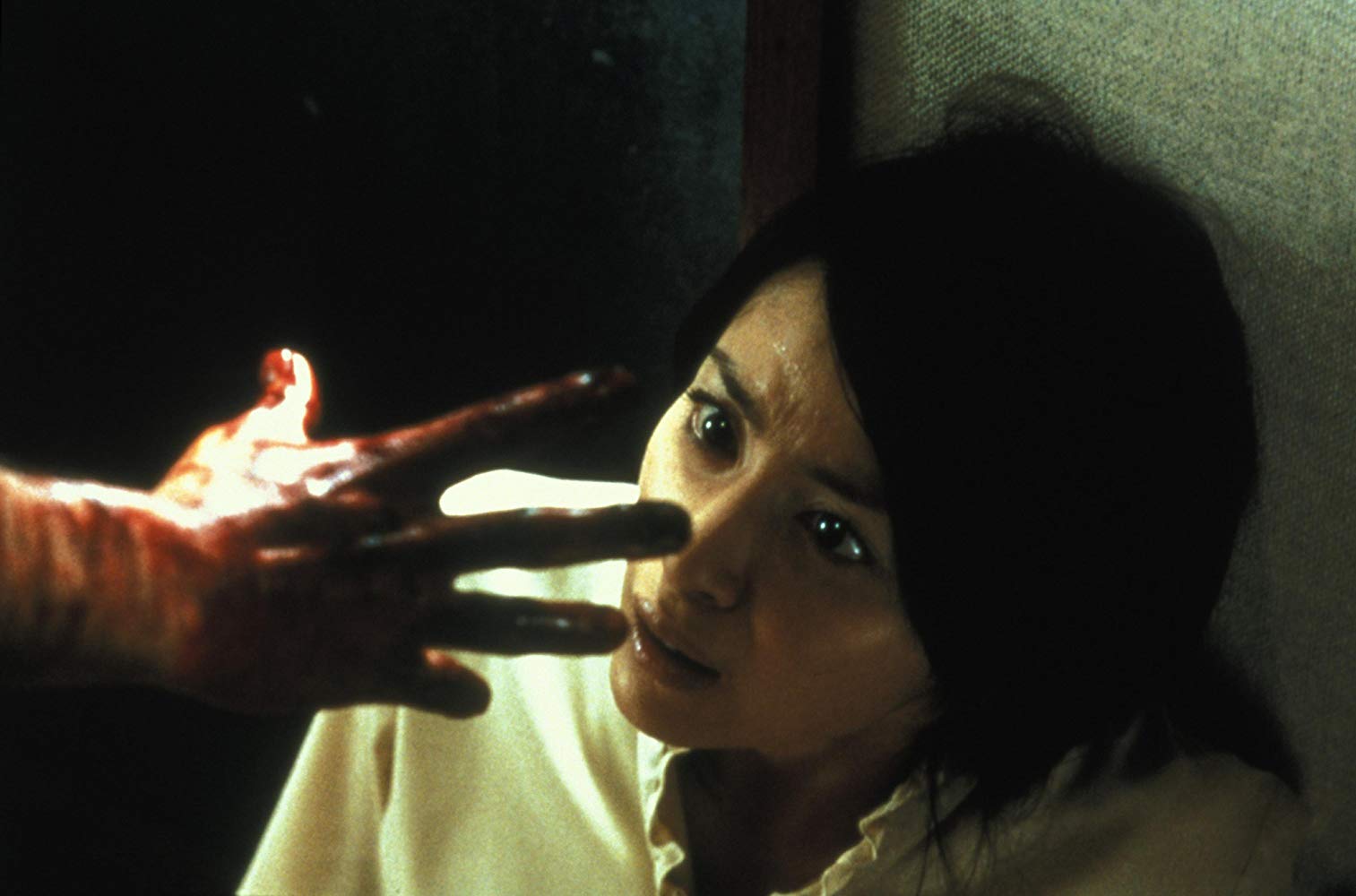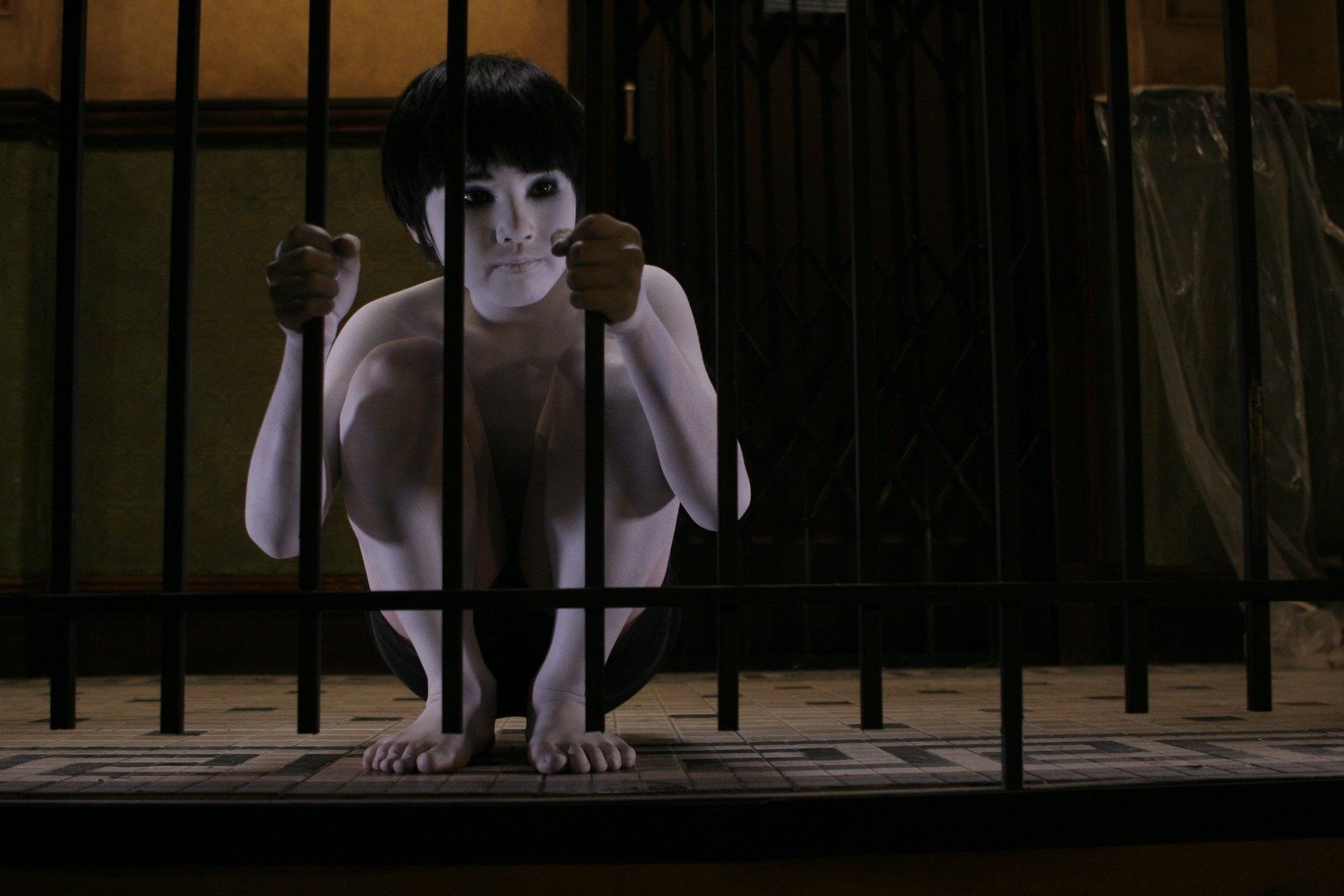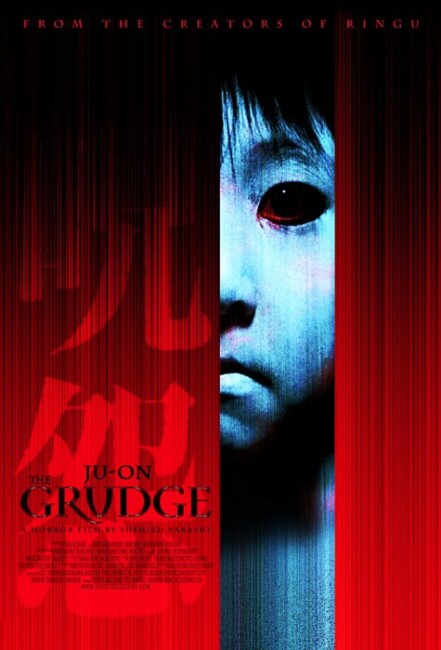Japan. 2003.
Crew
Director/Screenplay – Takashi Shimizu, Producer – Taka Ichise, Photography – Tokusho Kikumura, Music – Shiro Sato, Production Design – Toshiharu Tokiwa. Production Company – Oz.
Cast
Megumi Okina (Nishina Rika), Misaki Ito (Tokunaga Hitomi), Kanji Tsuda (Tokunaga Katsuya), Shuri Matsuda (Tokunaga Kazumi), Misa Uehara (Toyama Izumi), Yoji Tanaka (Detective Toyama Yuji), Hirokazu Inoue (Detective Nakagawa), Takako Fuji (Kayako), Kayoko Shibata (Mariko), Saisuke Honda (Detective Igarishi), Yui Ichikawa (Chiharu), Yukako Kukuri (Miyuki), Chikako Isomura (Sachie), Chikara Ishikura (Hirohashi), Yuya Ozeki (Toshio)
Plot
Social worker Rika goes to help an elderly woman at the Tokunaga household and discovers a mysterious boy in the house. Earlier, Katsuya, the husband of the household, returned home to find his wife Kazumi in shock and was then haunted by the mystery boy. His sister Hitomi is also haunted after entering the house. Police enter the house to find Rika in a state of shock. The boy she reports seeing is found to have gone missing under mysterious circumstances. The police contact Toyama, the original investigating detective, but he, followed by his teenage daughter Izumi, is then haunted after he tries to return to the house.
Like most of the films to emerge from the new wave of Japanese horror (or J-horror), Ju-on: The Grudge owes its inspiration to the work that started the Japanese horror renaissance – the massively successful Ring (1998). Ju-on: The Grudge bears a number of resemblances to Ring – the curse that is passed onwards, the female creature with the hair covering its face, haunted things happening on video screens.
Ju-on: The Grudge is one of the spookiest films that one can recall having sit down to watch in a theatre in some time. Director Takashi Shimizu creates a genuinely haunted atmosphere. The film is filled with scenes that evoke an intense uncanniness. There is a spooky little boy who is perpetually turning up everywhere – under restaurant tables, hiding behind the bars at the top of a stairwell, in bed with one of the heroines, even at one point emerging from inside a victim’s blouse.
There are other images that are highly disconcerting – the unearthly looking woman with the long, disjointed back and hair draped across her eyes who is seen crawling down stairs, emerging from toilet cubicles, accompanied by bizarre croaking noises. Or the mysterious black shadow that one heroine finds hovering over a comatose old woman. In fact, director Takashi Shimizu creates a spooky, haunted atmosphere far better than Ring itself does.

On the other hand, exactly as much as one praises the atmosphere of the film, one can equally condemn The Grudge for its almost entire lack of plot. The film is divided into eight chapters with each given the name of the person who becomes victim to the curse. Yet there is almost nothing in the way of plot that connects these episodes together. The episodes are not even in chronological order. There is no explanation of what is behind the hauntings, who the boy and the other ghosts are, why this particular house is haunted and why some victims are chosen.
There is a title card at the start that explains that the ‘ju-on’ is a curse that continues after death when someone dies in a fit of rage and is passed from person to person but the script never deigns to explain who died in anger and how this relates to the little boy and mysterious woman. There is reference made to the boy’s mysterious disappearance but little is explained about this, while similarly the detective Toyama is said to have investigated what happened at the house but exactly what is unclear. There is also reference made to three missing schoolgirls but again what they have to do with things is equally unclear.
Some of this could well be cleared up when one realises that The Grudge is not a stand-alone film but is actually the third in a series. The first was Ju-on (2000), which similarly told a series of connected episodes about a haunting centred around a house, and was followed by Ju-on 2 (2000), which continued in the same vein. Both were directed by Takashi Shimizu but intended for video rather than theatrical release and much lower budgeted. Both also feature the ghost boy and long-haired woman and follow the same basic idea of everybody who comes in contact with them being fatally haunted. (Prior to this, Takashi Shimizu delivered the basics of what would become the Ju-on films with the tv movie School Ghost Story G (1998) where was hired to direct two of the four segments). Ju-on: The Grudge is a big-screen reworking of the two video films.

This film was followed by Ju-on: The Grudge 2 (2003). Shimizu was also employed to direct an English-language remake The Grudge (2004), starring Sarah Michelle Gellar. Shimizu also directed its sequel The Grudge 2 (2006) and there was a third film The Grudge 3 (2009) from an American director. Shimizu has overseen two other films in the series from other directors Ju-on: Girl in Black (2009) and Ju-on: Old Lady in White (2009), as well as directed the videogame Ju-on: The Grudge (2009). There was also a subsequent reboot film with Ju-on: The Beginning of the End (2014), which produced a sequel with Ju-on: The Final Curse (2015), followed by Sadako vs Kayako (2016), a crossover with the Ring series, and the tv series Ju-on: Origins (2020). The Grudge (2020) was a reboot of the US series.
Takashi Shimizu has since shaped up to be a major name in Japanese horror. Aside from the Ju-on/Grudge series, he has made Tomie: Rebirth (2001), an entry in another Japanese ghost story series; the exceedingly strange and unclassifiable Marebito (2004) about a man finding a vampire-like woman beneath the Tokyo subway; the ghost story Reincarnation (2005); an episode of the anthology Ten Nights of Dreams (2006); The Shock Labyrinth (2009); Rabbit Horror 3D (2011); the live-action version of Hayao Miyazaki’s Kiki’s Delivery Service (2014); the English-language airplane horror 7500 (2014); the ghost story A Rain Woman (2016); Innocent Curse (2017) about abducted children returned with a curse; Howling Village (2019) about a haunted village; Homunculus (2021), Suicide Forest Village (2021), Oxhead Village (2022) about a cursed box; the Virtual Reality film Immersion (2023); and the horror fiilm Sana (2023).
(Winner in this site’s Top 10 Films of 2003 list. Nominee for Best Director (Takashi Shimizu) at this site’s Best of 2003 Awards).
Trailer here


